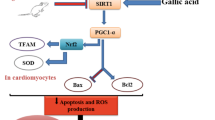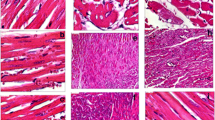Abstract
There is a growing need for pharmacological agents to manage cardiovascular disease in the rapidly growing elderly population. Here, we determine if acetaminophen is efficacious in decreasing age-related increases in cardiac reactive oxygen species (ROS) and apoptosis in aging Fischer 344 X Brown Norway rats. Compared to 6-month control animals, indices of oxidative (superoxide anion [O2•–] and 4-hydroxy-2-nonenal [4-HNE]) and nitrosative (protein nitrotyrosylation) stress were markedly increased in 33-month-old rat hearts. 33-month animals that had been treated with acetaminophen (30 mg/kg/day p.o. for 6 months) exhibited diminished age-related increases in cardiac ROS levels and TUNEL positive nuclei and these changes were accompanied by improvements in the Bax/Bcl2 ratio, diminished evidence of caspase-3 activation and increased phosphorylation of protein kinase B, ERK1/2, p70S6K and GSK-3β. Taken together these results suggests that acetaminophen may attenuate the age-associated increases in the cardiomyocyte apoptosis, possibly via diminishing age associated elevation in ROS production.










Similar content being viewed by others
References
Adler A, Messina E, Sherman B, Wang Z, Huang H, Linke A, Hintze TH (2003) NAD(P)H oxidase-generated superoxide anion accounts for reduced control of myocardial O2 consumption by NO in old Fischer 344 rats. Am J Physiol Heart Circ Physiol 285:H1015–H1022
Ameer B, Greenblatt DJ (1977) Acetaminophen. Ann Intern Med 87:202–209
Asano S, Rice KM, Kakarla S, Katta A, Desai DH, Walker EM, Wehner P, Blough ER (2007) Aging influences multiple indices of oxidative stress in the heart of the Fischer 344/NNia x Brown Norway/BiNia rat. Redox Rep 12:167–180
Balasubramanian S, Johnston RK, Moschella PC, Mani SK, Tuxworth WJ Jr, Kuppuswamy D (2009) mTOR in growth and protection of hypertrophying myocardium. Cardiovasc Hematol Agents Med Chem 7:52–63
Berger JS, Roncaglioni MC, Avanzini F, Pangrazzi I, Tognoni G, Brown DL (2006) Aspirin for the primary prevention of cardiovascular events in women and men: a sex-specific meta-analysis of randomized controlled trials. JAMA 295:306–313
Besse S, Bulteau AL, Boucher F, Riou B, Swynghedauw B, de Leiris J (2006) Antioxidant treatment prevents cardiac protein oxidation after ischemia–reperfusion and improves myocardial function and coronary perfusion in senescent hearts. J Physiol Pharmacol 57:541–552
Boengler K, Buechert A, Heinen Y, Roeskes C, Hilfiker-Kleiner D, Heusch G, Schulz R (2008) Cardioprotection by ischemic postconditioning is lost in aged and STAT3-deficient mice. Circ Res 102:131–135
Boengler K, Konietzka I, Buechert A, Heinen Y, Garcia-Dorado D, Heusch G, Schulz R (2007) Loss of ischemic preconditioning’s cardioprotection in aged mouse hearts is associated with reduced gap junctional and mitochondrial levels of connexin 43. Am J Physiol Heart Circ Physiol 292:H1764–H1769
Boengler K, Schulz R, Heusch G (2009) Loss of cardioprotection with ageing. Cardiovasc Res 83:247–261
Boutaud O, Aronoff DM, Richardson JH, Marnett LJ, Oates JA (2002) Determinants of the cellular specificity of acetaminophen as an inhibitor of prostaglandin H(2) synthases. Proc Natl Acad Sci USA 99:7130–7135
Burlacu A (2003) Regulation of apoptosis by Bcl-2 family proteins. J Cell Mol Med 7:249–257
Carter WO, Narayanan PK, Robinson JP (1994) Intracellular hydrogen peroxide and superoxide anion detection in endothelial cells. J Leukoc Biol 55:253–258
Casas-Terradellas E, Tato I, Bartrons R, Ventura F, Rosa JL (2008) ERK and p38 pathways regulate amino acid signalling. Biochim Biophys Acta 1783:2241–2254
Chou TM, Greenspan P (2002) Effect of acetaminophen on the myeloperoxidase-hydrogen peroxide-nitrite mediated oxidation of LDL. Biochim Biophys Acta 1581:57–63
Comporti M (1998) Lipid peroxidation and biogenic aldehydes: from the identification of 4-hydroxynonenal to further achievements in biopathology. Free Radic Res 28:623–635
Das A, Salloum FN, Xi L, Rao YJ, Kukreja RC (2009) ERK phosphorylation mediates sildenafil-induced myocardial protection against ischemia–reperfusion injury in mice. Am J Physiol Heart Circ Physiol 296:H1236–H1243
Dhingra S, Sharma AK, Singla DK, Singal PK (2007) p38 and ERK1/2 MAPKs mediate the interplay of TNF-alpha and IL-10 in regulating oxidative stress and cardiac myocyte apoptosis. Am J Physiol Heart Circ Physiol 293:H3524–H3531
Dinis TC, Maderia VM, Almeida LM (1994) Action of phenolic derivatives (acetaminophen, salicylate, and 5-aminosalicylate) as inhibitors of membrane lipid peroxidation and as peroxyl radical scavengers. Arch Biochem Biophys 315:161–169
Dost T, Cohen MV, Downey JM (2008) Redox signaling triggers protection during the reperfusion rather than the ischemic phase of preconditioning. Basic Res Cardiol 103:378–384
Fischer PHilfiker-Kleiner D (2007) Survival pathways in hypertrophy and heart failure: the gp130-STAT axis. Basic Res Cardiol 102:393–411
Flora SJ (2007) Role of free radicals and antioxidants in health and disease. Cell Mol Biol (Noisy-le-grand) 53:1–2
Franklin SS (1999) Cardiovascular risks related to increased diastolic, systolic and pulse pressure. An epidemiologist’s point of view. Pathol Biol (Paris) 47:594–603
Golfetti R, Rork T, Merrill G (2003) Chronically administered acetaminophen and the ischemia/reperfused myocardium. Exp Biol Med (Maywood) 228:674–682
Griendling KK, Sorescu D, Ushio-Fukai M (2000) NAD(P)H oxidase: role in cardiovascular biology and disease. Circ Res 86:494–501
Hadzimichalis NM, Baliga SS, Golfetti R, Jaques KM, Firestein BL, Merrill GF (2007) Acetaminophen-mediated cardioprotection via inhibition of the mitochondrial permeability transition pore-induced apoptotic pathway. Am J Physiol Heart Circ Physiol 293:H3348–H3355
Hare JM (2001) Oxidative stress and apoptosis in heart failure progression. Circ Res 89:198–200
Hengartner MO (2000) The biochemistry of apoptosis. Nature 407:770–776
Kakarla SK, Rice KM, Katta A, Paturi S, Wu M, Kolli M, Keshavarzian S, Manzoor K, Wehner PS, Blough ER Possible molecular mechanisms underlying age-related cardiomyocyte apoptosis in the F344XBN rat heart. J Gerontol A Biol Sci Med Sci 65:147–155
Konishi H, Matsuzaki H, Tanaka M, Takemura Y, Kuroda S, Ono Y, Kikkawa U (1997) Activation of protein kinase B (Akt/RAC-protein kinase) by cellular stress and its association with heat shock protein Hsp27. FEBS Lett 410:493–498
Kwak HB, Song W, Lawler JM (2006) Exercise training attenuates age-induced elevation in Bax/Bcl-2 ratio, apoptosis, and remodeling in the rat heart. Faseb J 20:791–793
Lakatta E (1994) Aging effects on the vasculature in health: risk factors for cardiovascular disease. Am J Geriatr Cardiol 3:11–17
Lakatta EG (1998) Cardiovascular aging: perspectives from humans to rodents. Am J Geriatr Cardiol 7:32–45
Lauer T, Heiss C, Balzer J, Kehmeier E, Mangold S, Leyendecker T, Rottler J, Meyer C, Merx MW, Kelm M, Rassaf T (2008) Age-dependent endothelial dysfunction is associated with failure to increase plasma nitrite in response to exercise. Basic Res Cardiol 103:291–297
Laurent S (1995) Arterial wall hypertrophy and stiffness in essential hypertensive patients. Hypertension 26:355–362
Lee HCWei YH (2007) Oxidative stress, mitochondrial DNA mutation, and apoptosis in aging. Exp Biol Med (Maywood) 232:592–606
Li DY, Tao L, Liu H, Christopher TA, Lopez BL, Ma XL (2006) Role of ERK1/2 in the anti-apoptotic and cardioprotective effects of nitric oxide after myocardial ischemia and reperfusion. Apoptosis 11:923–930
Liu L, Zhang XJ, Jiang SR, Ding ZN, Ding GX, Huang J, Cheng YL (2007) Heat shock protein 27 regulates oxidative stress-induced apoptosis in cardiomyocytes: mechanisms via reactive oxygen species generation and Akt activation. Chin Med J (Engl) 120:2271–2277
Los M, Maddika S, Erb B, Schulze-Osthoff K (2009) Switching Akt: from survival signaling to deadly response. Bioessays 31:492–495
Merrill G, McConnell P, Vandyke K, Powell S (2001) Coronary and myocardial effects of acetaminophen: protection during ischemia-reperfusion. Am J Physiol Heart Circ Physiol 280:H2631–H2638
Merrill GFGoldberg E (2001) Antioxidant properties of acetaminophen and cardioprotection. Basic Res Cardiol 96:423–430
Merrill GF, Rork TH, Spiler NM, Golfetti R (2004) Acetaminophen and myocardial infarction in dogs. Am J Physiol Heart Circ Physiol 287:H1913–H1920
Nakamoto K, Kamisaki Y, Wada K, Kawasaki H, Itoh T (1997) Protective effect of acetaminophen against acute gastric mucosal lesions induced by ischemia–reperfusion in the rat. Pharmacology 54:203–210
Oltvai ZN, Milliman CL, Korsmeyer SJ (1993) Bcl-2 heterodimerizes in vivo with a conserved homolog, Bax, that accelerates programmed cell death. Cell 74:609–619
Pletjushkina OY, Fetisova EK, Lyamzaev KG, Ivanova OY, Domnina LV, Vyssokikh MY, Pustovidko AV, Alexeevski AV, Alexeevski DA, Vasiliev JM, Murphy MP, Chernyak BV, Skulachev VP (2006) Hydrogen peroxide produced inside mitochondria takes part in cell-to-cell transmission of apoptotic signal. Biochemistry (Mosc) 71:60–67
Qin SChock PB (2003) Implication of phosphatidylinositol 3-kinase membrane recruitment in hydrogen peroxide-induced activation of PI3K and Akt. Biochemistry 42:2995–3003
Ray SD, Lam TS, Rotollo JA, Phadke S, Patel C, Dontabhaktuni A, Mohammad S, Lee H, Strika S, Dobrogowska A, Bruculeri C, Chou A, Patel S, Patel R, Manolas T, Stohs S (2004) Oxidative stress is the master operator of drug and chemically-induced programmed and unprogrammed cell death: Implications of natural antioxidants in vivo. Biofactors 21:223–232
Rosner M, Fuchs C, Siegel N, Valli A, Hengstschlager M (2009) Functional interaction of mammalian target of rapamycin complexes in regulating mammalian cell size and cell cycle. Hum Mol Genet 18:3298–3310
Shimizu N, Yoshiyama M, Omura T, Hanatani A, Kim S, Takeuchi K, Iwao H, Yoshikawa J (1998) Activation of mitogen-activated protein kinases and activator protein-1 in myocardial infarction in rats. Cardiovasc Res 38:116–124
Song G, Ouyang G, Bao S (2005) The activation of Akt/PKB signaling pathway and cell survival. J Cell Mol Med 9:59–71
Ungvari Z, Gupte SA, Recchia FA, Batkai S, Pacher P (2005) Role of oxidative-nitrosative stress and downstream pathways in various forms of cardiomyopathy and heart failure. Curr Vasc Pharmacol 3:221–229
Wagner C, Tillack D, Simonis G, Strasser RH, Weinbrenner C Ischemic post-conditioning reduces infarct size of the in vivo rat heart: role of PI3-K, mTOR, GSK-3beta, and apoptosis. Mol Cell Biochem
Wencker D, Chandra M, Nguyen K, Miao W, Garantziotis S, Factor SM, Shirani J, Armstrong RC, Kitsis RN (2003) A mechanistic role for cardiac myocyte apoptosis in heart failure. J Clin Invest 111:1497–1504
Wu M, Desai DH, Kakarla SK, Katta A, Paturi S, Gutta AK, Rice KM, Walker EM Jr, Blough ER (2009) Acetaminophen prevents aging-associated hyperglycemia in aged rats: effect of aging-associated hyperactivation of p38-MAPK and ERK1/2. Diabetes Metab Res Rev 25:279–286
Xu Z, Ji X, Boysen PG (2004) Exogenous nitric oxide generates ROS and induces cardioprotection: involvement of PKG, mitochondrial KATP channels, and ERK. Am J Physiol Heart Circ Physiol 286:H1433–H1440
Zha H, Aime-Sempe C, Sato T, Reed JC (1996) Proapoptotic protein Bax heterodimerizes with Bcl-2 and homodimerizes with Bax via a novel domain (BH3) distinct from BH1 and BH2. J Biol Chem 271:7440–7444
Zhao H, Kalivendi S, Zhang H, Joseph J, Nithipatikom K, Vasquez-Vivar J, Kalyanaraman B (2003) Superoxide reacts with hydroethidine but forms a fluorescent product that is distinctly different from ethidium: potential implications in intracellular fluorescence detection of superoxide. Free Radic Biol Med 34:1359–1368
Acknowledgments
Funding for this work was provided in part from a grant to ERB from Mc Neil Pharmaceuticals.
Author information
Authors and Affiliations
Corresponding author
Rights and permissions
About this article
Cite this article
Kakarla, S.K., Fannin, J.C., Keshavarzian, S. et al. Chronic acetaminophen attenuates age-associated increases in cardiac ROS and apoptosis in the Fischer Brown Norway rat. Basic Res Cardiol 105, 535–544 (2010). https://doi.org/10.1007/s00395-010-0094-3
Received:
Revised:
Accepted:
Published:
Issue Date:
DOI: https://doi.org/10.1007/s00395-010-0094-3




